Education is a fundamental aspect of any society, shaping the future workforce and citizenry. The United Kingdom (UK) and the United States of America (USA) have established education systems that, while sharing some similarities, also have distinct differences. This comparative analysis explores the structure, curriculum, assessment methods, and higher education in both countries.
Structure
The education systems in the UK and the USA are structured differently. In the UK, education is divided into several stages: Early Years Foundation Stage (ages 3-5), Primary Education (ages 5-11), Secondary Education (ages 11-16), and Further Education (ages 16-18). Higher education typically begins at age 18. Secondary education in the UK culminates in the General Certificate of Secondary Education (GCSE) exams, followed by Advanced Level (A-Level) exams or vocational qualifications.
In the USA, education is typically divided into Elementary School (grades K-5), Middle School (grades 6-8), High School (grades 9-12), and Higher Education. High school students earn a diploma upon graduation, usually at age 18, and may choose to take Advanced Placement (AP) courses and exams or the International Baccalaureate (IB) program to prepare for college.
Curriculum
The UK and USA education systems differ significantly in their curriculum approaches. In the UK, the National Curriculum sets out the subjects and content to be taught at each stage, ensuring a standardized education across the country. Core subjects include English, Mathematics, Science, and Humanities. Students can specialize in certain subjects at the A-Level stage, which plays a critical role in university admissions.
In contrast, the USA does not have a national curriculum. Instead, education standards are set at the state level, leading to variations in the subjects taught and the content covered. The Common Core State Standards Initiative, adopted by many states, aims to standardize English and Mathematics education. However, the curriculum remains more flexible, allowing schools and teachers significant autonomy in designing and delivering lessons.
Assessment Methods
Assessment methods in the UK and USA also vary. In the UK, standardized exams play a crucial role in the education system. Students take GCSE exams at the end of Secondary Education, which assess their knowledge and skills in various subjects. Those who continue to A-Levels face rigorous exams that universities heavily consider during admissions.
In the USA, assessment methods include a combination of standardized tests and continuous assessment. High school students take standardized tests such as the SAT or ACT for college admissions. Additionally, classroom assessments, including quizzes, tests, projects, and participation, contribute to a student’s overall grade. This continuous assessment approach provides a broader evaluation of a student’s abilities and knowledge over time.
Higher Education
Higher education in the UK and USA also exhibits notable differences. In the UK, undergraduate degrees typically take three years to complete (four in Scotland). Students apply to specific degree programs through the centralized Universities and Colleges Admissions Service (UCAS), often with a clear idea of their field of study. University education is highly specialized, with students focusing primarily on their chosen subject from the start.
In the USA, undergraduate degrees usually take four years to complete. Students apply to universities and can often remain undeclared or change majors during their first two years, allowing exploration of various disciplines before specializing. The liberal arts education model emphasizes a well-rounded education, with students required to take courses across multiple disciplines.
Funding and Costs
Funding and costs associated with education differ significantly between the two countries. In the UK, education is publicly funded, with most schools receiving government funding. Higher education fees are capped for domestic students, and financial support is available through loans and grants. International students typically face higher tuition fees.
In the USA, public schools are funded through local, state, and federal sources. Higher education costs are generally higher than in the UK, with significant variation between in-state and out-of-state tuition at public universities and higher costs at private institutions. Financial aid is available through federal and state programs, scholarships, and loans, but student debt remains a significant issue.
Conclusion
The education systems in the UK and USA each have unique characteristics shaped by their historical, cultural, and socio-economic contexts. While both aim to provide quality education and prepare students for future success, the approaches to curriculum design, assessment, higher education, and funding demonstrate key differences. Understanding these differences provides valuable insights into how each system strives to meet the educational needs of its population and the challenges they face in an evolving global landscape.

Leave a Reply